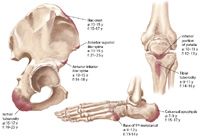Apophysitis of the lower extremities
Overuse injuries are becoming more common in young athletes because of early sport specialization, year-round sports participation, participation in multiple sports in the same season, and increased training demands.
Overuse injuries are becoming more common in young athletes because of early sport specialization, year-round sports participation, participation in multiple sports in the same season, and increased training demands.1 Apophysitis is an overuse injury unique to the skeletally immature athlete and comprises a significant proportion of musculoskeletal complaints in this population.
The apophysis is a secondary ossification center that serves as the attachment site for a muscle-tendon unit.1-3 In the growing athlete, the apophysis is the biomechanically weak point of the muscle-tendon-bone attachment and is subject to injury from repetitive stress or an acute avulsion injury.1,4 An avulsion fracture occurs as a result of a forceful muscle contraction displacing a small piece of bone from its origin. Apophysitis refers to the irritation, inflammation, and microtrauma resulting from overuse injury to the apophysis.1,2,4
Contributing factors
Presentation
In general, apophysitis presents with gradual onset of pain without a specific history of injury; however, it also may present as persistent and/or worsening symptoms after a single traumatic event.3 Athletes generally localize their pain to the apophysis.
Apophysitis typically develops from repetitive submaximal loading at the apophysis, but a forceful eccentric (lengthening) muscle contraction may cause an acute avulsion fracture at the apophysis, with immediate disability.4-7 These injuries are distinguished by the history. Questions regarding current sports or activities, level and conditions of training, change in activity level, and presence of a recent growth spurt are helpful in understanding factors that contribute to the development of apophysitis. Parents and athletes can be reassured that symptoms typically resolve once growth at the apophysis is complete, but symptoms may occur intermittently until that time.1 Because most athletes desire to continue participating in their sport, the goal of treatment is to decrease pain and address contributing factors.
Diagnosis
The diagnosis of apophysitis can be made solely on the basis of classic history and physical exam findings. Radiographs are not necessary for diagnosis but may help rule out other conditions such as infection or tumor, especially with an atypical history, or when concerning historical factors such as night pain, fever, weight loss, or pain persisting after skeletal maturity are present.1 If radiographs are not obtained initially but the athlete has persistent symptoms or is not responding to therapy, then x-rays or advanced imaging such as magnetic resonance imaging (MRI) should be considered.
Treatment
Unfortunately, evidence-based reports of treatment for apophysitis are lacking in the literature, but treatment protocols generally follow the same principles. First, one must provide rest from activities that cause pain and protect the apophysis from further injury. Providers must keep in mind that an open growth plate is still vulnerable to injury, and, although rare, inadequate protection of the apophysis during a time of increased stress can result in an avulsion fracture. Activity may be modified to allow continued participation, but certain athletes require complete rest depending on their level of pain and disability. A general rule is that sports participation is allowed as long as limping is not present during normal walking or during or after activity. A rehabilitation program in the form of a home exercise program, formal physical therapy, or rehab with an athletic trainer is used to correct underlying flexibility and strength deficits.1
